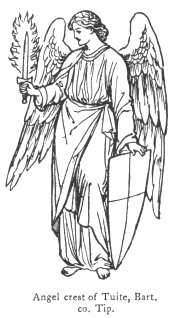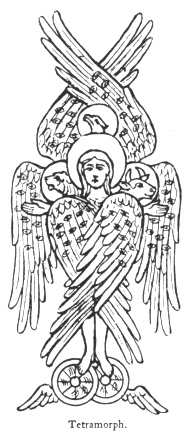
Sacred Texts Legendary Creatures Symbolism Index Previous Next
Buy this Book at Amazon.com


Fictitious and Symbolic Creatures in Art, by John Vinycomb, [1909], at sacred-texts.com
In Ecclesiastical Art literal renderings of the descriptions contained in the Old Testament and the Apocalypse are not of unfrequent use. A more lengthened reference to these great Hebrew symbolic beings will not be considered out of place, as there is great doubt and uncertainty as to their forms.
These mystic symbolic beings were familiar to all the patriarchs—from Adam, who gazed upon them in Paradise, and against whom on his expulsion they stood with flaming sword, turning every way to bar his return—to Moses, who trembled before it on Mount Sinai; while to the Priests and Levites, the custodians of the Ark of the Covenant in the Tabernacle, the
cherubim remained the sacred guardians in the Holy of Holies of the palladium of the national faith and liberties during the brightest and, as it has been termed, the most heroic period of Jewish history.
Josephus, the more effectually to excite respect for
 |
To the prophetic vision of Ezekiel, the description of which, in the opinion of competent critics, excels in grandeur of idea and energy of expression the most celebrated writers of ancient and modern times, the reader is referred, as it supplies at first hand
almost all that can be known concerning the fearful form of the cherubim.
The four living creatures that support the throne of God exhibited to Ezekiel a fourfold aspect; they had each the face of a man, the face of a lion, and the face of an ox; they also had the face of an eagle. They had each four wings; they had the hands of a man under their wings. "Two wings of every one were joined one to the other, and two covered their bodies." They were accompanied by wheels which "went upon their four sides, and they turned not when they went"; "and their whole body, and their backs, and their hands, and their wings, and their wheels were full of eyes"; and the living creatures ran and returned as the appearance of a flash of lightning." Such is a concise description of their appearance as set forth in Ezekiel (chap. i.).
"This wonderful and mysterious hieroglyph must be considered as a striking and expressive emblem of the guardian vigilance of providence, all-seeing and omniscient; while the number of wings exhibit to us direct symbols of that powerful, that all-pervading spirit which, while it darts through nature at a glance, is everywhere present to protect and defend us" (Dideron).
So attached were the Jews to this celestial symbol that when Solomon erected that stupendous temple which continued the glory and boast of the Hebrew nation for so many ages, we are told (1 Kings, vi. 29, viii. 6, 7), he carved all the walls of the house
round about with the sculptured figures of the cherubim, and on each side of the ark was a cherub of gold plated upon olive wood fifteen feet high, with their faces to the light, their expanded wings embracing the whole space of the sacred enclosure, serving as a visible sign or symbol of God's immediate presence, whence the saying of David, "God sitteth between the cherubim" (Ps. xcix. 1). In this place God perpetually resided in the form of a bright cloud or shining luminous body, termed "shechinah," whence the divine oracles were audibly delivered.
Milton gives the following description of the Seraph Raphael:
The cherub is traditionally regarded as a celestial spirit which in the hierarchy is placed next in order
to the seraphim. All the several descriptions which the Scripture gives us of cherubim differ from one another, as they are described in the shapes of men, eagles, oxen, lions, and in a composition of all these figures put together. The hieroglyphical representations in the embroidery upon the curtains of the tabernacle were called by Moses (Ex. xxvi. 1) "cherubim of cunning work" (Calmet).
The seraphim are regarded as an order of angels distinguished for fervent zeal and religious ardour. The word means burning," i.e., with Divine Love.
The seraphim are described by Isaiah (vi. 1––3): "I saw also the Lord sitting upon a throne, high and lifted up, and his train filled the temple. Above it stood the seraphim: each one had six wings; with twain he covered his face, and with twain he covered his feet, and with twain he did fly. And one cried to another and said, Holy, Holy, Holy, is the Lord of Hosts: the whole earth is full of his glory." And in Revelation (iv. 6): "Round about the throne were four beasts full of eyes before and behind, and the first beast was like a lion, and the second beast like a calf, and the third beast had a face as a man, and the fourth beast was like a flying eagle. And the four beasts had each of them six wings about him, and they were full of eyes within." It will be noticed that these descriptions differ from that of Ezekiel, not only in the number of wings, but also in the individuality of each beast being separate and independent, not compounded of the four.
Several forms of these mystical creatures, says Audsley, have been devised by the early mediæval artists; those which display the entire forms of
 |
Pugin's "Glossary of Ecclesiastical Ornament and Costume" says the cherubim are frequently represented of a bright red colour to set forth the intensity of divine love, and usually standing upon wheels, in reference to the vision of the prophet Ezekiel.
Cherubim and seraphim seem always vested in the alb or tunic, and a scarf tied in a knot round the neck.